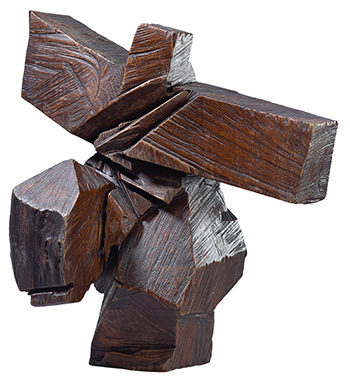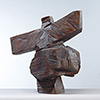Catalogue Note:
Ju Ming was born in 1938 in Tunghsiao, Miaoli County, which is a center of wood carving in Taiwan. He received very little formal education in the arts, and at the age of 15, he was apprenticed to Lee Chin-chuan, a famous traditional master wood-carver. When he was 30, he decided to give up a well-paid position as a chief craftsman in a large woodcarving factory. He left Miaoli to study sculpture with the master sculptor Yuyu Yang with whom he studied for eight years. Yang suggested to Ju Ming that he take up Taichi boxing, the traditional Chinese boxing, as he had a frail constitution, and it would help him to improve his health. Ju Ming soon discovered that practicing the ancient 'martial art' did more than just make him stronger: it gave him much food for thought and opened up profound new vistas for his creative work. Ju gained first hand experience of the awe-inspiring vital force that circulates through all living creatures, and as he gradually adopted this new philosophy and internalized its principles, he also started to express it in his art.
Ju Ming says, "Taichi is a method, invented by the ancient Chinese, of maintaining your health through regular soft exercise. It is also the best example of 'achieving oneness between man and nature' that I am aware of. Through our own body (i.e. our four limbs, internal organs, blood and breath) taichi allows us to directly experience and emulate the natural phenomena that make up our universe" Ju's lifelong pursuit of taichi's natural rhythm is manifest in his sculptures. Having internalized the principles of this ancient sport through constant practice, he is able to merge taichi and art into straightforward, unadulterated representations of man's union with nature. "Taichi Series" marked the maturation of his sculptural language and aesthetic style, securing his status as one of the most acclaimed figures in contemporary art. This series drew him away from the traditional themes he explored in the past and into a type of pure spiritualism that marked the beginning of his mature phase in modern sculpture.
In his "Taichi" series, Ju Ming takes basic skills of shadow boxing as the elements of traditional picture for shaping and further replacing the traditional connotation in it, applying the massive touch sense and concise patch sense of modern sculpture, Ju Ming, as an artist, has expressed his understanding on image of mutual integration and accommodation of Chinese and western cultures. The Taichi series has seen remarkable transformations from its beginning in the late 1970s. In the early years, when the sculptures were made of wood, Ju Ming was basically using traditional woodworking axes and knives, but over time he gradually switched over to using saws for the initial cutting, and then removing additional material from the wood by hand or with a saw, following the grain of the wood. In this way, the material became a more effective medium for the content of what Ju Ming wanted to express, the medium in fact became the content, thereby enhancing the vitality of the symbolism. His travels in Europe brought about the most revolutionary transformation in his approach towards this subject. His encounters with the stone architecture of ancient Rome brought him profound inspiration. As a result, his works since the 1990s took on cleaner contours and a more sublime sense of monumentality.
Ju Ming saw man as being a part of nature, rather than standing in opposition to nature. The “Taichi” series took the essential nature of humankind as its starting-point for contacting and imitating various natural phenomena that exist within the cosmos, thereby exploring channels for communication between man and nature. There is an emphasis on learning from nature, which has echoes of Zen Buddhist thought. Later works in the “Taichi” series placed more emphasis on the relationship between the individual and the group; the human figures are somehow closed in on themselves, unlike the more flamboyant works of Ju Ming’s earlier period. The statues from this later period have little in the way of decorative finishing; the carving is more intense, in a way reminiscent of traditional Chinese ink brush painting.
This rare piece of wooden “Taichi” series was executed in 1992, depicting the classic posture of Taichi-- Golden Rooster Standing. Golden Rooster Standing is clean and simple in form but voluminous in its presence. The artist has made use of clean and precise sculptural cutting to mold the voluminous surface area. From the waist to the shoulder runs an astonishingly bold cutting mark that vividly models the energy and sense of speed of a kick from the right leg. Art critic Chang Tsong-zung has said: "In the sculptural art of Ju Ming the signature cutting strokes are attuned by their usage in sculpting figurative form, where spirit and likeness should be captured with minimal strokes ". Ju Ming's Taichi sculptures depict diverse movements expressing a delicate balance between movement and immobility.
Ju Ming says, "Taichi is a method, invented by the ancient Chinese, of maintaining your health through regular soft exercise. It is also the best example of 'achieving oneness between man and nature' that I am aware of. Through our own body (i.e. our four limbs, internal organs, blood and breath) taichi allows us to directly experience and emulate the natural phenomena that make up our universe" Ju's lifelong pursuit of taichi's natural rhythm is manifest in his sculptures. Having internalized the principles of this ancient sport through constant practice, he is able to merge taichi and art into straightforward, unadulterated representations of man's union with nature. "Taichi Series" marked the maturation of his sculptural language and aesthetic style, securing his status as one of the most acclaimed figures in contemporary art. This series drew him away from the traditional themes he explored in the past and into a type of pure spiritualism that marked the beginning of his mature phase in modern sculpture.
In his "Taichi" series, Ju Ming takes basic skills of shadow boxing as the elements of traditional picture for shaping and further replacing the traditional connotation in it, applying the massive touch sense and concise patch sense of modern sculpture, Ju Ming, as an artist, has expressed his understanding on image of mutual integration and accommodation of Chinese and western cultures. The Taichi series has seen remarkable transformations from its beginning in the late 1970s. In the early years, when the sculptures were made of wood, Ju Ming was basically using traditional woodworking axes and knives, but over time he gradually switched over to using saws for the initial cutting, and then removing additional material from the wood by hand or with a saw, following the grain of the wood. In this way, the material became a more effective medium for the content of what Ju Ming wanted to express, the medium in fact became the content, thereby enhancing the vitality of the symbolism. His travels in Europe brought about the most revolutionary transformation in his approach towards this subject. His encounters with the stone architecture of ancient Rome brought him profound inspiration. As a result, his works since the 1990s took on cleaner contours and a more sublime sense of monumentality.
Ju Ming saw man as being a part of nature, rather than standing in opposition to nature. The “Taichi” series took the essential nature of humankind as its starting-point for contacting and imitating various natural phenomena that exist within the cosmos, thereby exploring channels for communication between man and nature. There is an emphasis on learning from nature, which has echoes of Zen Buddhist thought. Later works in the “Taichi” series placed more emphasis on the relationship between the individual and the group; the human figures are somehow closed in on themselves, unlike the more flamboyant works of Ju Ming’s earlier period. The statues from this later period have little in the way of decorative finishing; the carving is more intense, in a way reminiscent of traditional Chinese ink brush painting.
This rare piece of wooden “Taichi” series was executed in 1992, depicting the classic posture of Taichi-- Golden Rooster Standing. Golden Rooster Standing is clean and simple in form but voluminous in its presence. The artist has made use of clean and precise sculptural cutting to mold the voluminous surface area. From the waist to the shoulder runs an astonishingly bold cutting mark that vividly models the energy and sense of speed of a kick from the right leg. Art critic Chang Tsong-zung has said: "In the sculptural art of Ju Ming the signature cutting strokes are attuned by their usage in sculpting figurative form, where spirit and likeness should be captured with minimal strokes ". Ju Ming's Taichi sculptures depict diverse movements expressing a delicate balance between movement and immobility.


